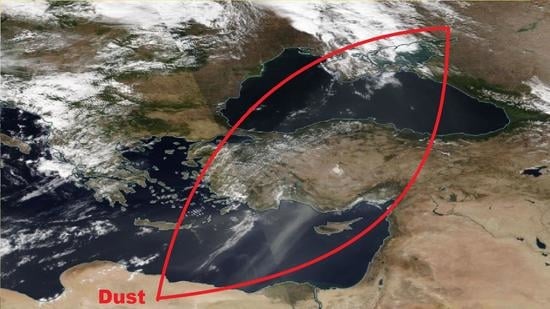Why Is It Important to Consider Dust Aerosol in the Sevastopol and Black Sea Region during Remote Sensing Tasks? A Case Study
Abstract
:1. Introduction
2. Materials and Methods
2.1. Study Area
2.2. Field Measurements
2.2.1. Aerosol Concentration Measurements
2.2.2. Atmospheric Measurements
2.3. Satellite Data
3. Results
3.1. In Situ Spectra
3.1.1. MODIS In Situ Spectra
3.1.2. Atmospheric Data
3.2. Comparison of Satellite and In Situ AOT
3.3. Comparison of Atmospheric Parameters
4. Discussion
5. Conclusions
Author Contributions
Funding
Data Availability Statement
Acknowledgments
Conflicts of Interest
References
- Barber, P.W.; Hill, S.C. Light Scattering by Particles: Computational Methods; World Scientific: Singapore, 1990; 261p. [Google Scholar]
- Vermote, E.F.; El Saleous, N.Z.; Justice, C.O. Atmospheric correction of MODIS data in the visible to middle infrared: First results. Remote Sens. Environ. 2002, 83, 97–111. [Google Scholar] [CrossRef]
- Lyapustin, A.; Wang, Y. MAIAC-Multi-Angle Implementation of Atmospheric Correction for MODIS. AGU Spring Meet. Abstr. 2007, 2007, A51B-05. [Google Scholar]
- Vasiliev, A.B.; Ivlev, L.S.; Kugeyko, M.M.; Lysenko, S.A.; Terekhin, N.Y. Evaluation of the accuracy of control measurements in the problems of optical diagnostics of microphysical parameters of aerosol. Opt. Atmos. Ocean 2009, 22, 873–881. [Google Scholar]
- Firsov, K.M.; Bobrov, E.V. Restoring the aerosol optical thickness by ground measurements of SPM photometer. Math. Phys. Comput. Model. 2014, 2, 21. [Google Scholar]
- Kalinskaya, D.V.; Kabanov, D.M.; Latushkin, A.A.; Sakerin, S.M. Atmospheric aerosol optical thickness measurements in the Black sea region (2015–2016). Atmos. Ocean. Opt. 2017, 6, 489–496. [Google Scholar]
- Suslin, V.V.; Slabakova, V.K.; Kalinskaya, D.V.; Pryakhina, S.F.; Golovko, N.I. Optical features of the Black Sea aerosol and the sea water upper layer based on in situ and satellite measurements. Phys. Oceanogr. 2016, 1, 20–32. [Google Scholar]
- Ueda, S.; Miura, K.; Kawata, R.; Furutani, H.; Uematsu, M.; Omori, Y.; Tanimoto, H. Number–size distribution of aerosol particles and new particle formation events in tropical and subtropical Pacific Oceans. Atmos. Environ. 2016, 142, 324–339. [Google Scholar] [CrossRef] [Green Version]
- Mordas, G.; Plauškaitė, K.; Prokopčiuk, N.; Dudoitis, V.; Bozzetti, C.; Ulevicius, V. Observation of new particle formation on Curonian Spit located between continental Europe and Scandinavia. J. Aerosol Sci. 2016, 97, 38–55. [Google Scholar] [CrossRef]
- Kalinskaya, D.V.; Papkova, A.S. Optical characteristics of atmospheric aerosol from satellite and photometric measurements at the dust transfers dates. In Proceedings of the SPIE 26th International Symposium on Atmospheric and Ocean Optics, Atmospheric Physics, Moskow, Russia, 12 November 2020. [Google Scholar] [CrossRef]
- Lee, Z.; Marra, J.; Perry, M.J.; Kahru, M. Estimating oceanic primary productivity from ocean color remote sensing: A strategic assessment. J. Mar. Syst. 2015, 149, 50–59. [Google Scholar] [CrossRef]
- Karalli, P.G.; Glukhovets, D.I. Retrieving optical characteristics of the Russian Arctic seas water surface layer from shipboard and satellite data. Mod. Probl. Remote Sens. Earth Space 2020, 17, 191–202. [Google Scholar] [CrossRef]
- Gordon, H.R.; Wang, M. Retrieval of water-leaving radiance and aerosol optical thickness over the oceans with SeaWiFS: A preliminary algorithm. Appl. Opt. 1994, 33, 443–452. [Google Scholar] [CrossRef] [PubMed]
- Ahmad, Z.; Franz, B.; McClain, C.; Kwiatkowska, E.; Werdell, J.; Shettle, E.; Holben, B. New aerosol models for the retrieval of aerosol optical thickness and normalized water-leaving radiances from the SeaWiFS and MODIS sensors over coastal regions and Open Oceans. Appl. Opt. 2010, 49, 5545–5560. [Google Scholar] [CrossRef] [PubMed]
- Wang, M.; Gordon, H.R. A Simple, Moderately Accurate, Atmospheric Correction Algorithm for SeaWiFS. Remote Sens. Environ. 1994, 50, 231–239. [Google Scholar] [CrossRef]
- Varenik, A.V.; Kalinskaya, D.V. The Effect of Dust Transport on the Concentration of Chlorophyll-A in the Surface Layer of the Black Sea. Appl. Sci. 2021, 11, 4692. [Google Scholar] [CrossRef]
- Suetin, V.; Korolev, S.N.; Suslin, V.V.; Kucheryavyi, A.A. Improved interpretation of the data of observations of the black sea by a SeaWiFS satellite instrument in autumn 1998. Phys. Oceanogr. 2008, 18, 106–115. [Google Scholar] [CrossRef]
- Suetin, V.S.; Korolev, S.N.; Kucheryaviy, A.A. Sun Glint Manifestation at Evaluating the Black Sea Water Optical Parameters using Satellite Measurements. Phys. Oceanogr. 2016, 3, 47–56. [Google Scholar]
- Korchemkina, E.N.; Kalinskaya, D.V. Algorithm of Additional Correction of Level 2 Remote Sensing Reflectance Data Using Modelling of the Optical Properties of the Black Sea Waters. Remote Sens. 2022, 14, 831. [Google Scholar] [CrossRef]
- Suslin, V.V.; Suetin, V.S.; Korolev, S.N.; Kucheryaviy, A.A. Desert dust effects in the results of atmospheric correction of satelle sea color observations. In Proceedings of the 4th International Conference on Current Problems in Optics of Natural Waters, Nizhny Novgorod, Russia, 11–15 September 2007; pp. 184–187. [Google Scholar]
- Kalinskaya, D.V. Osobennosti opticheskikh kharakteristik pylevogo aerozol over the Black Sea [Features of optical characteristics of a dust aerosol over the Black Sea]. Ekologicheskaya bezopasnost coastal and shelf zones and complex use of shelf resources. Sci. Period. Ukr. 2012, 26, 151–162. Available online: http://nbuv.gov.ua/UJRN/ebpsz_2012_26%282%29__14 (accessed on 26 February 2022).
- Papkova, A.S.; Shibanov, E.B. Influence of dust aerosol on the results of atmospheric correction of remote sensing reflection of the Black and Mediterranean Seas from MODIS satellite data. Sovrem. Probl. Distantsionnogo Zondirovaniya Zemli Kosm. 2021, 18, 46–56. [Google Scholar] [CrossRef]
- Papkova, A.; Papkov, S.; Shukalo, D. Prediction of the Atmospheric Dustiness over the Black Sea Region Using the WRF-Chem Model. Fluids 2021, 6, 201. [Google Scholar] [CrossRef]
- Zhang, M.; Hu, C.; Barnes, B.B. Performance of POLYMER Atmospheric Correction of Ocean Color Imagery in the Presence of Absorbing Aerosols. IEEE Trans. Geosci. Remote Sens. 2019, 57, 6666–6674. [Google Scholar] [CrossRef]
- Gilerson, A.A.; Gitelson, A.A.; Zhou, J.; Gurlin, D.; Moses, W.; Ioannou, I.; Ahmed, S.A. Algorithms for remote estimation of chlorophyll-a in coastal and inland waters using red and near infrared bands. Opt. Express 2010, 18, 24109–24125. [Google Scholar] [CrossRef] [PubMed] [Green Version]
- Sakerin, S.M.; Kabanov, D.M.; Rostov, A.P.; Turchinovich, S.A.; Knyazev, V.V. Sun photometers for measuring spectral air transparency in stationary and mobile conditions. Atmos. Ocean. Opt. 2013, 26, 352–356. [Google Scholar] [CrossRef]
- Kabanov, D.M.; Veretennikov, V.V.; Voronina, Y.V.; Sakerin, S.M.; Turchinovich, Y.S. Information system for network solar photometers. Atmos. Ocean. Opt. 2009, 22, 121–127. [Google Scholar] [CrossRef]
- Kuznetsova, I.N.; Glazkova, A.A.; Shalygina, I.Y.; Nakhaev, M.I.; Arkhangel’skaya, A.A.; Zvyagintsev, A.M.; Semutnikova, E.G.; Zakharova, P.V.; Lezina, E.A. Seasonal and diurnal variability of particulate matter PM10 in surface air of Moscow habitable districts. Opt. Atmos. Okeana 2014, 27, 473–482. (In Russian) [Google Scholar]
- O’Neill, N.T.; Eck, T.F.; Smirnov, A.; Holben, B.N.; Thulasiraman, S. Spectral discrimination of coarse and fine mode optical depth. J. Geophys. Res. 2003, 108, 4559–4573. [Google Scholar] [CrossRef]
- O’Neill, N.T.; Dubovik, O.; Eck, T.F. A modified Angstrom coefficient for the characterization of sub-micron aerosols. Appl. Opt. 2001, 40, 2368–2375. [Google Scholar] [CrossRef]
- Scottand, J.P.; Werdell, P.J. Comparing level-2 and level-3 satellite ocean color retrieval validation methodologies. Opt. Express 2019, 27, 30140–30157. [Google Scholar] [CrossRef]
- Liu, X.; Wang, M. Filling the Gaps of Missing Data in the Merged VIIRS SNPP/NOAA-20 Ocean Color Product Using the DINEOF Method. Remote Sens. 2019, 11, 178. [Google Scholar] [CrossRef] [Green Version]
- Bridget, N.S.; Stumpf, R.P.; Schaeffer, B.A.; Loftin, K.A.; Werdell, P.J. Performance metrics for the assessment of satellite data products: An ocean color case study. Opt. Express 2018, 26, 7404–7422. [Google Scholar] [CrossRef] [Green Version]


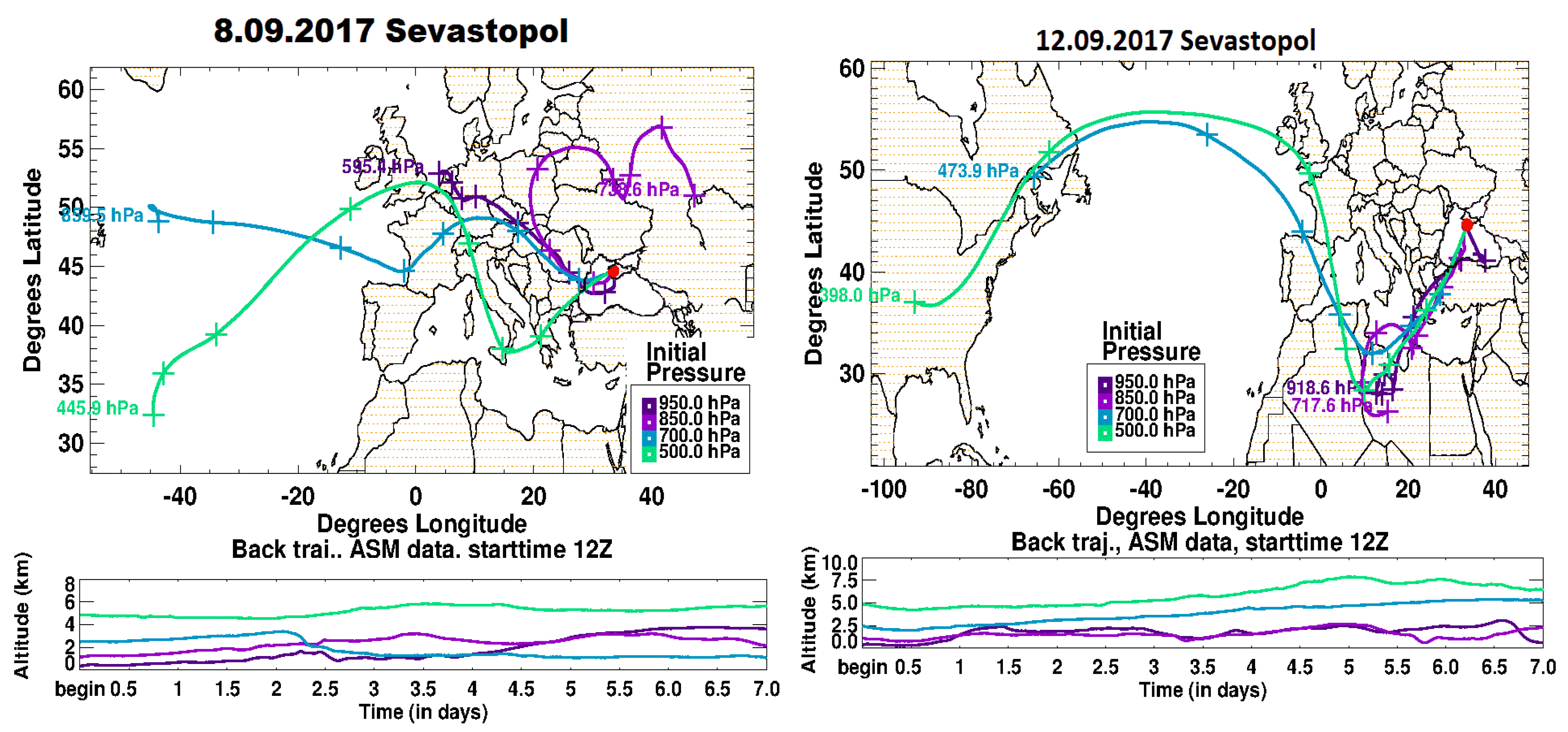
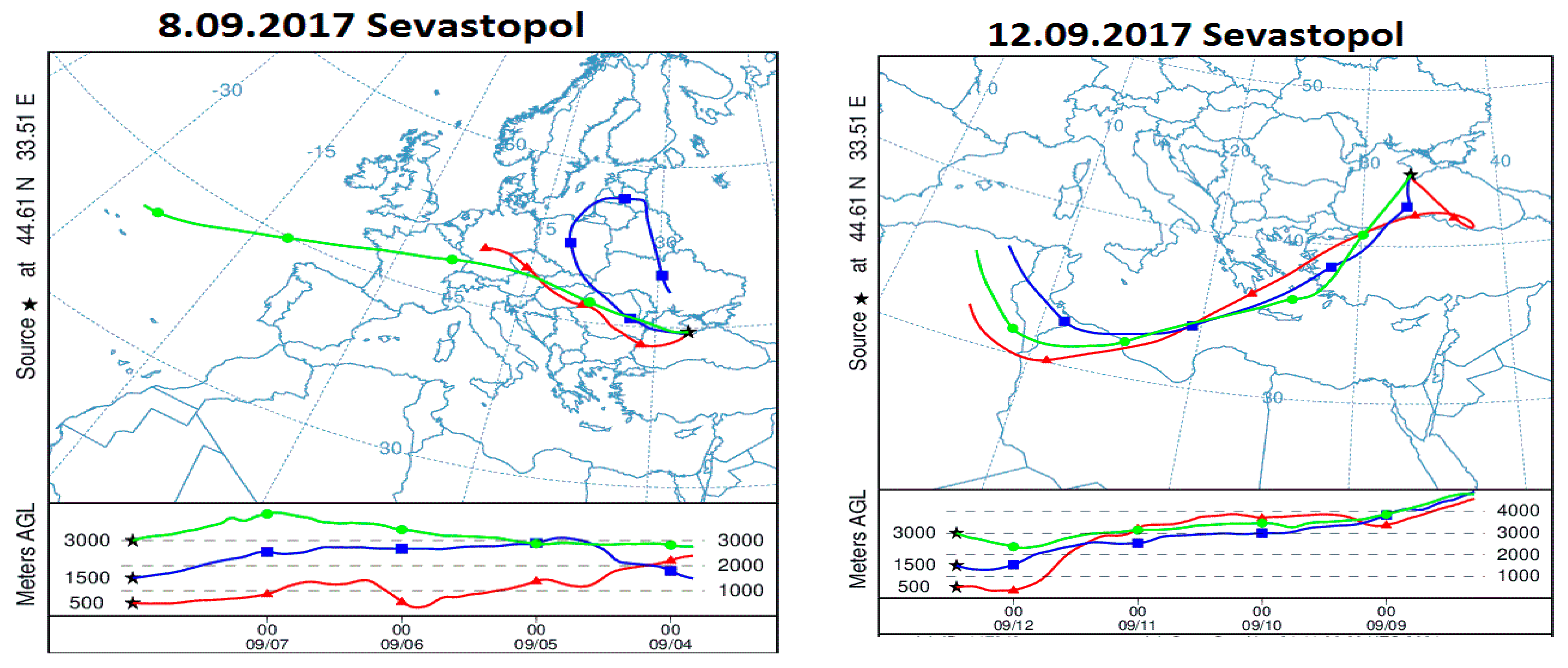

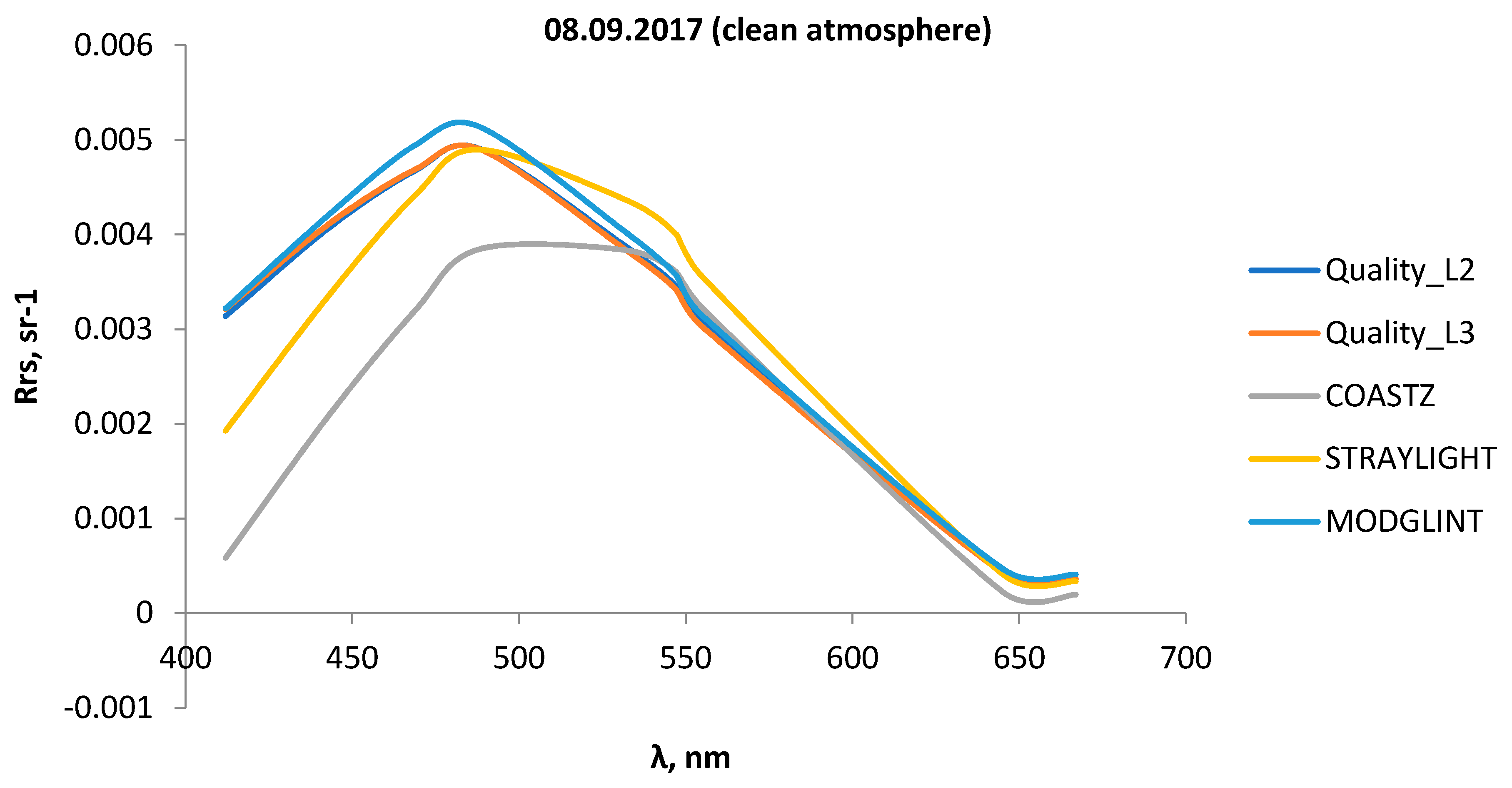
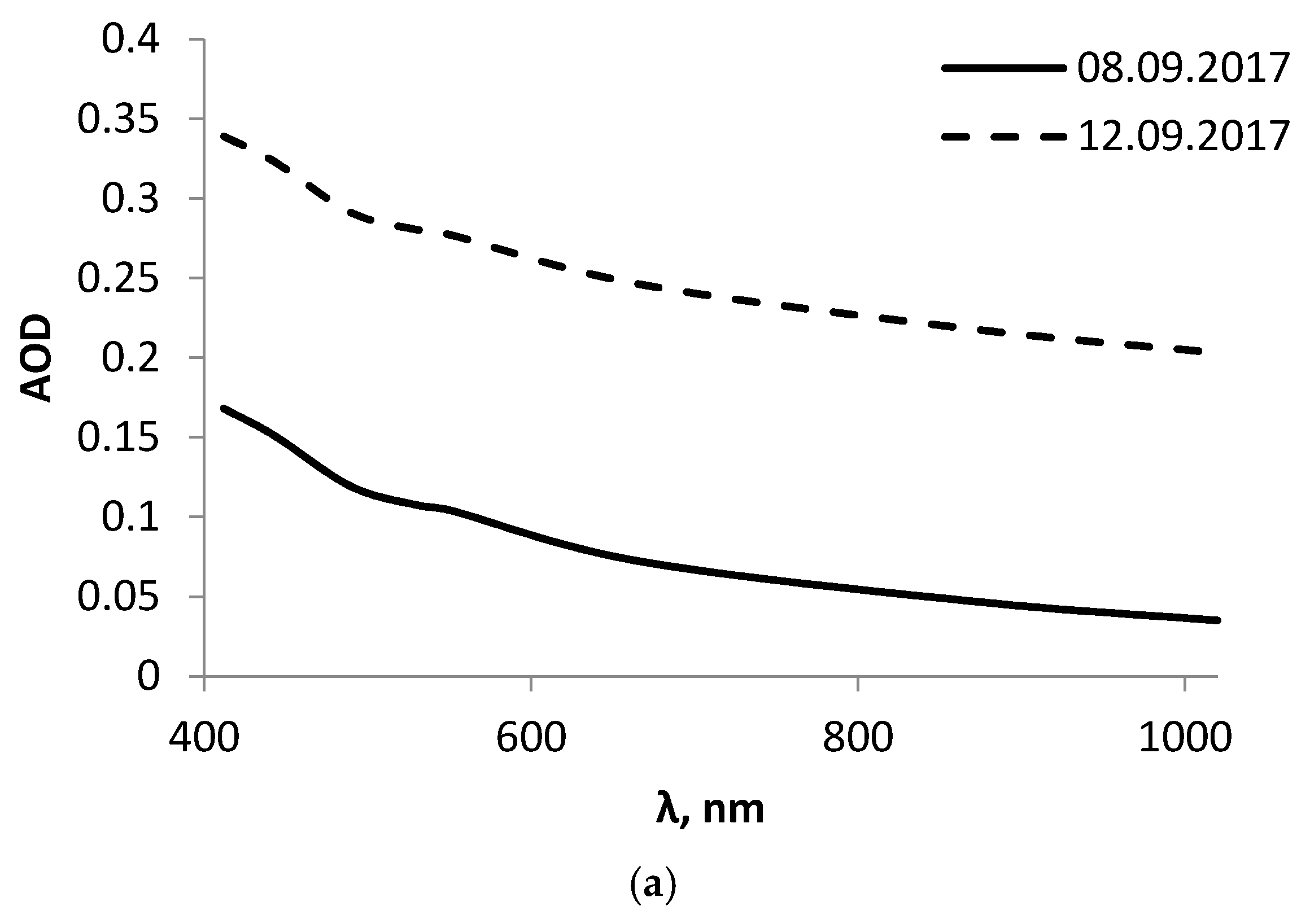

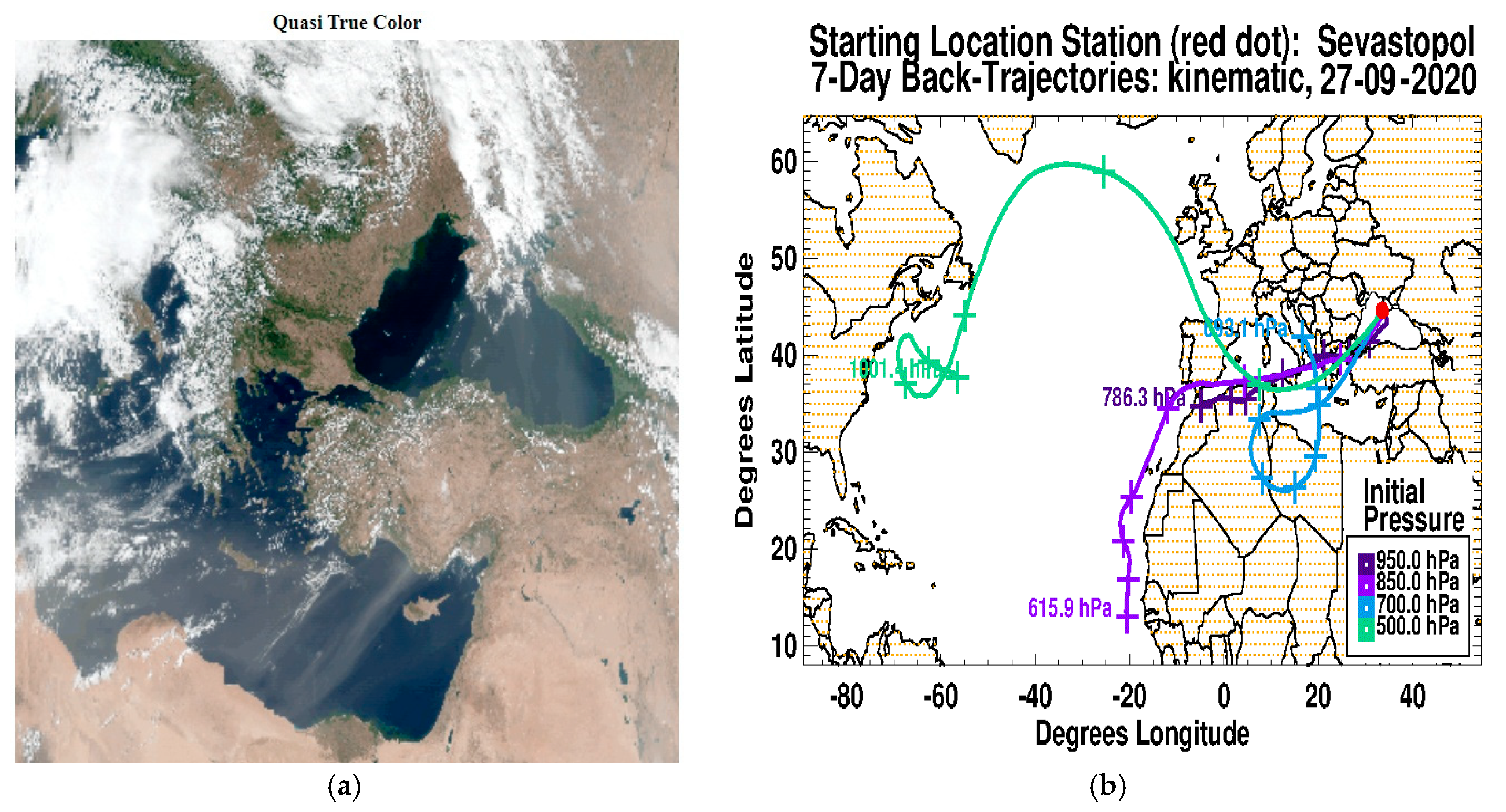
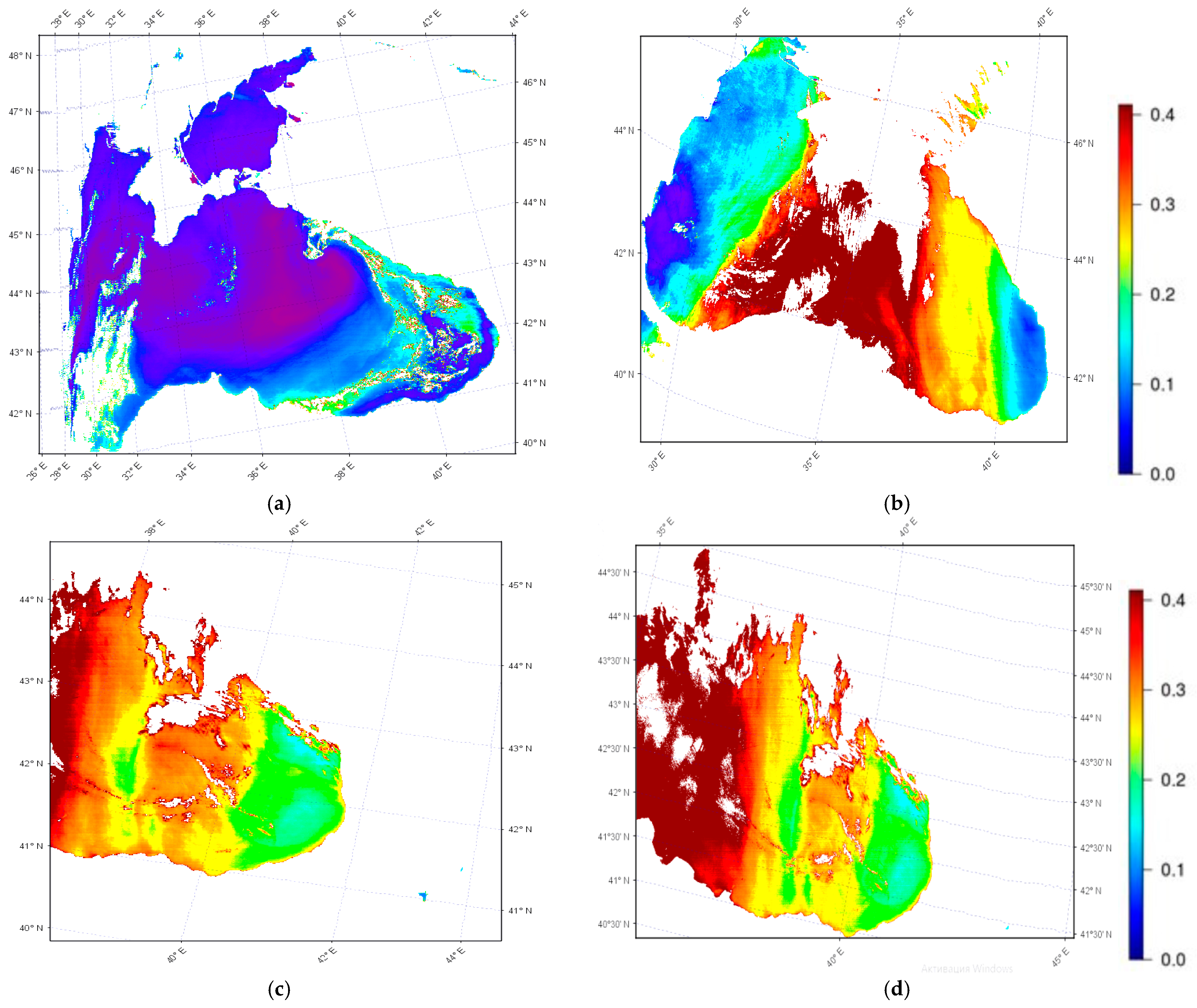
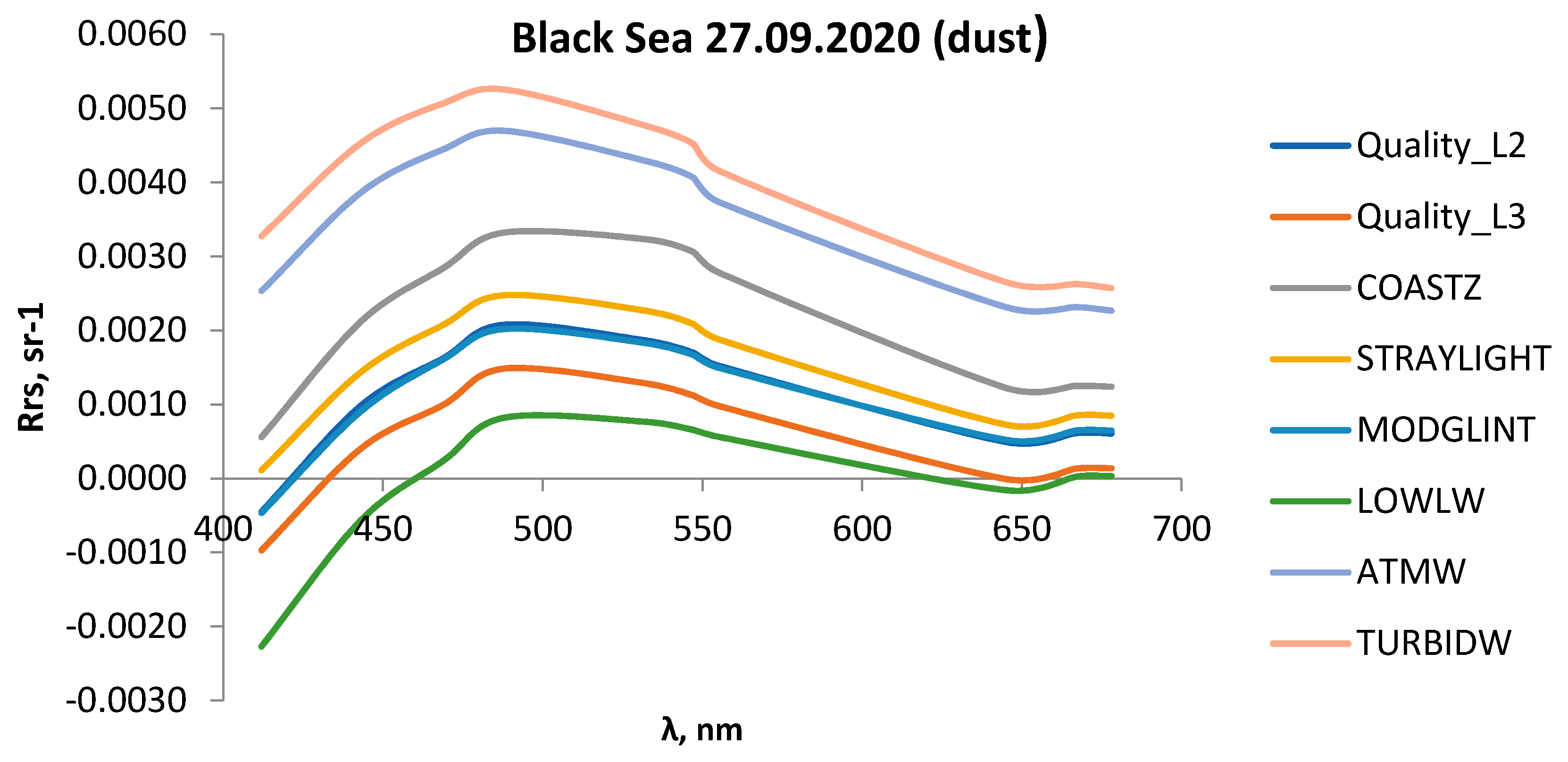
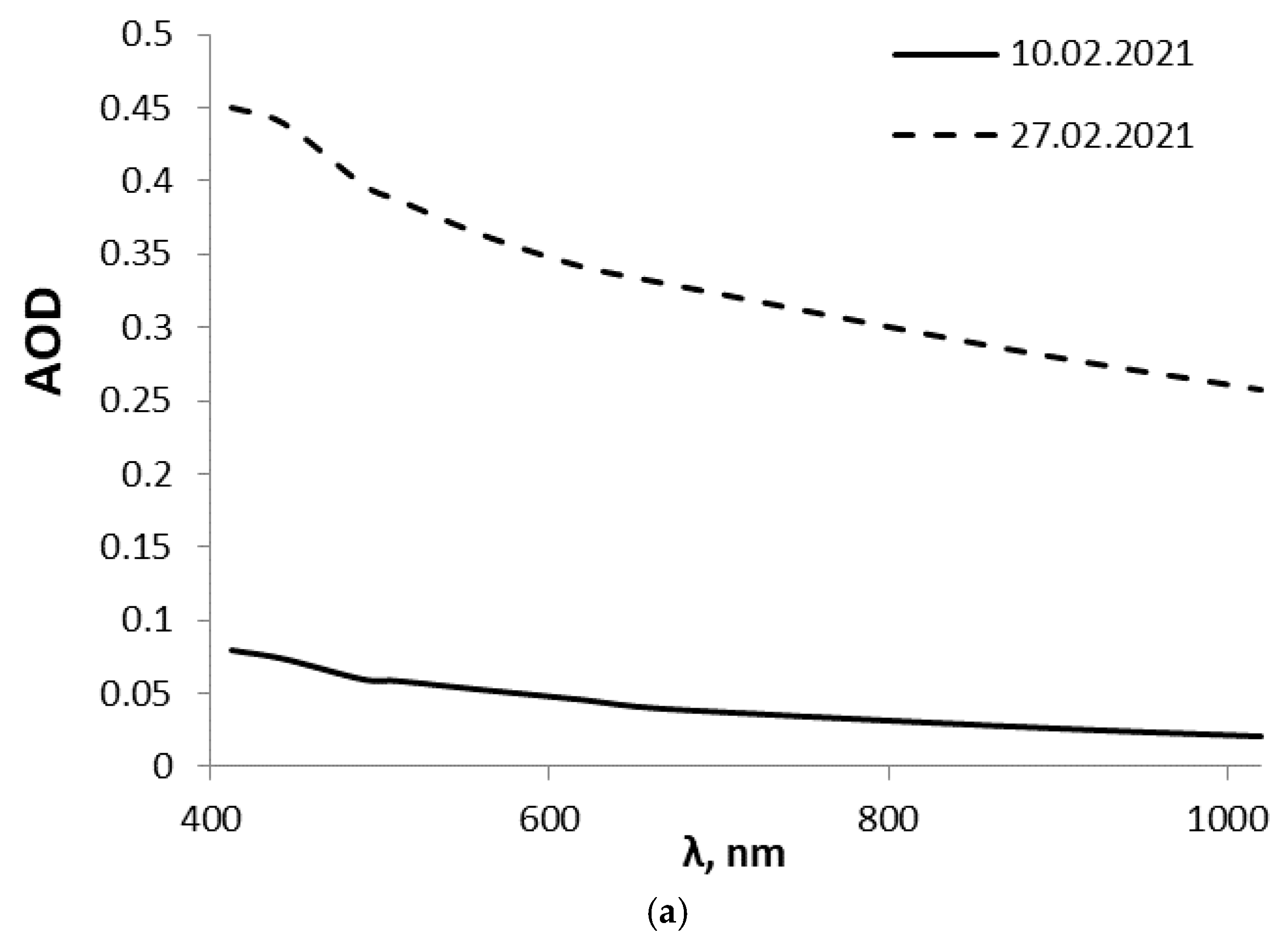

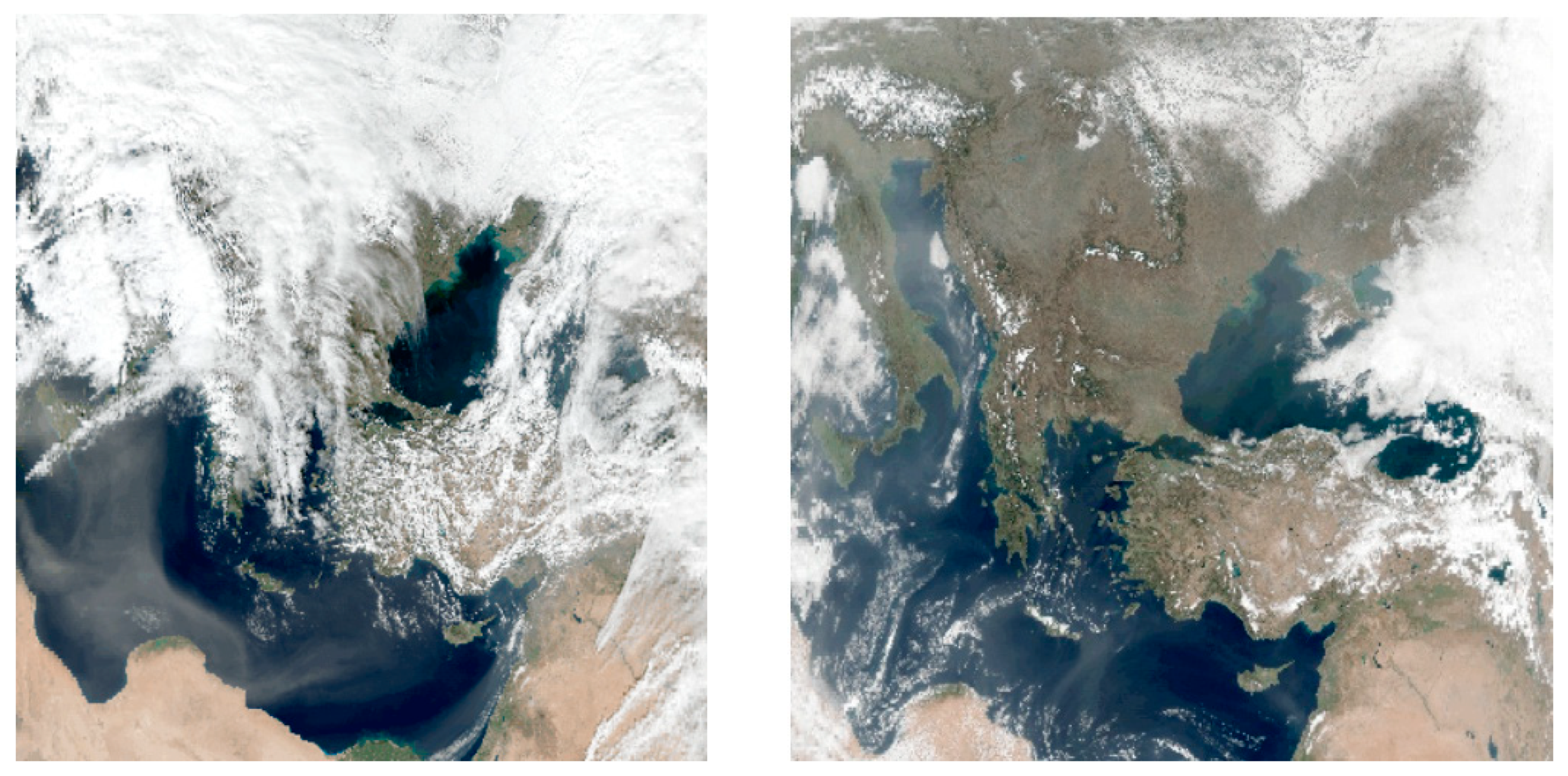

| 12.09.2017 | 08.09.2017 | |||
|---|---|---|---|---|
| Quality_L2 | Quality_L3 | Quality_L2 | Quality_L3 | |
| Pixels | 173,182 | 161,908 | 166,865 | 156,545 |
| AOT(869) | 0.161 | 0.157 | 0.034 | 0.033 |
| Angstrom | 1.393 | 1.410 | 1.673 | 1.67 |
| Rrs (412 nm) | −0.0002 | −0.00005 | 0.0031 | 0.0032 |
| Rrs (443 nm) | 0.00204 | 0.00211 | 0.0040 | 0.0041 |
| Rrs (469 nm) | 0.0033 | 0.003364 | 0.0046 | 0.0046 |
| Rrs (488 nm) | 0.0036 | 0.003645 | 0.0049 | 0.0049 |
| Rrs (531 nm) | 0.0030 | 0.003009 | 0.0039 | 0.0038 |
| Rrs (547 nm) | 0.0026 | 0.002664 | 0.0034 | 0.0034 |
| Rrs (555 nm) | 0.0023 | 0.002287 | 0.0030 | 0.0030 |
| Rrs (645 nm) | 0.0002 | 0.0002 | 0.0004 | 0.0004 |
| Rrs (667 nm) | 0.0002 | 0.0002 | 0.0003 | 0.0003 |
| Rrs (678 nm) | 0.0002 | 0.0002 | 0.0004 | 0.0004 |
| 12.09 Modis Aqua (10:37) | 12.09 Galata_Platform (07:13) | 08.09 Modis Aqua (11:04) | 08.09 VIIRS (11:11) | 08.09 Galata_Platform (08:04) | |
|---|---|---|---|---|---|
| AOT | 0.178 | 0.21 | 0.16 | 0.047 | 0.047 |
| α | 0.61 | 0.673 | 0.74 | 1.9098 | 1.68 |
| Rrs (410 nm) | 0.0018 | ||||
| Rrs (412 nm) | −0.0002 | 0.0017 | 0.0006 | 0.0019512 | |
| Rrs (443 nm) | 0.0009 | 0.00228 | 0.0016 | 0.0025 | 0.00222697 |
| Rrs (486 nm) | 0.00291 | ||||
| Rrs (488 nm) | 0.0018 | 0.0029 | 0.00237 | 0.0029 | |
| Rrs (531 nm) | 0.0015 | 0.00257 | 0.0020 | 0.002263 | |
| Rrs (547 nm) | 0.0013 | 0.00195 | 0.00172 | 0.0018418 | |
| Rrs (551 nm) | 0.0018 | ||||
| Rrs (555 nm) | 0.0011 | 0.00195 | 0.00154 | 0.00184311 | |
| Rrs (667 nm) | −0.00005 | 0.00023 | 0.0001 | 0.00033676 | |
| Rrs (671 nm) | 0.0001 |
| 10.09.2020 | 27.09.2020 | 29.09.2020 (MODIS) | 29.09.2020 (VIIRS) | |||||
|---|---|---|---|---|---|---|---|---|
| Quality_L2 | Quality_L3 | Quality_L2 | Quality_L3 | Quality_L2 | Quality_L3 | Quality_L2 | Quality_L3 | |
| Pixels | 102,965 | 99,512 | 104,986 | 100,470 | 33,027 | 25,111 | 32,688 | 25,096 |
| AOT(869) | 0.032 | 0.030 | 0.232 | 0.233 | 0.210 | 0.193 | 0.186 | 0.172 |
| Angstrom | 1.542 | 1.551 | 0.922 | 0.916 | 0.799 | 0.856 | 0.759 | 0.801 |
| Rrs (412 nm) | 0.003 | 0.003 | −0.001 | −0.001 | −0.001 | 0.000 | 0.000 | 0.000 |
| Rrs (443 nm) | 0.003 | 0.003 | 0.001 | 0.001 | 0.001 | 0.001 | 0.003 | 0.003 |
| Rrs (469 nm) | 0.004 | 0.004 | 0.002 | 0.002 | 0.001 | 0.001 | ||
| Rrs (488 nm) | 0.003 | 0.003 | 0.002 | 0.002 | 0.002 | 0.002 | 0.003 | 0.003 |
| Rrs (531 nm) | 0.003 | 0.003 | 0.002 | 0.002 | 0.001 | 0.001 | ||
| Rrs (547 nm) | 0.002 | 0.002 | 0.002 | 0.002 | 0.001 | 0.001 | 0.002 | 0.002 |
| Rrs (555 nm) | 0.002 | 0.002 | 0.002 | 0.002 | 0.001 | 0.001 | ||
| Rrs (645 nm) | 0.000 | 0.000 | 0.001 | 0.001 | 0.000 | 0.000 | ||
| Rrs (667 nm) | 0.000 | 0.000 | 0.001 | 0.001 | 0.000 | 0.000 | 0.000 | 0.002 |
| Rrs (678 nm) | 0.000 | 0.000 | 0.001 | 0.001 | 0.000 | 0.000 | ||
| 10.02.2021 | 27.02.2021 | ||
|---|---|---|---|
| Quality_L3 | Quality_L2 | Quality_L3 | |
| Rrs (411 nm) | 0.0018 | −0.002 | −0.0021 |
| Rrs (445 nm) | 0.0034 | 0.00087 | 0.00076 |
| Rrs (489 nm) | 0.0042 | 0.0026 | 0.0025 |
| Rrs (556 nm) | 0.0028 | 0.0029 | 0.0027 |
| Rrs (667 nm) | 0.0004 | 0.0006 | 0.0005 |
| 10.02.2021 (Section_7) | 27.02.2021 (Section_7) | |
|---|---|---|
| Lwn (412 nm) | 0.42815 | 0.241267 |
| Lwn (443 nm) | 0.559174 | 0.464439 |
| Lwn (490 nm) | 0.814275 | 0.675236 |
| Lwn (560 nm) | 1.218337 | 0.988313 |
| Lwn (667 nm) | 0.285271 | 0.282637 |
Publisher’s Note: MDPI stays neutral with regard to jurisdictional claims in published maps and institutional affiliations. |
© 2022 by the authors. Licensee MDPI, Basel, Switzerland. This article is an open access article distributed under the terms and conditions of the Creative Commons Attribution (CC BY) license (https://creativecommons.org/licenses/by/4.0/).
Share and Cite
Kalinskaya, D.V.; Papkova, A.S. Why Is It Important to Consider Dust Aerosol in the Sevastopol and Black Sea Region during Remote Sensing Tasks? A Case Study. Remote Sens. 2022, 14, 1890. https://doi.org/10.3390/rs14081890
Kalinskaya DV, Papkova AS. Why Is It Important to Consider Dust Aerosol in the Sevastopol and Black Sea Region during Remote Sensing Tasks? A Case Study. Remote Sensing. 2022; 14(8):1890. https://doi.org/10.3390/rs14081890
Chicago/Turabian StyleKalinskaya, Darya V., and Anna S. Papkova. 2022. "Why Is It Important to Consider Dust Aerosol in the Sevastopol and Black Sea Region during Remote Sensing Tasks? A Case Study" Remote Sensing 14, no. 8: 1890. https://doi.org/10.3390/rs14081890
APA StyleKalinskaya, D. V., & Papkova, A. S. (2022). Why Is It Important to Consider Dust Aerosol in the Sevastopol and Black Sea Region during Remote Sensing Tasks? A Case Study. Remote Sensing, 14(8), 1890. https://doi.org/10.3390/rs14081890





